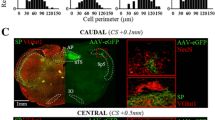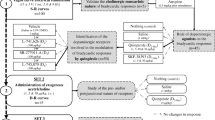Summary
In order to determine whether and how opiates affect vagal efferents, effects of fentanyl on single fibre discharge in the cervical vagus in dogs were studied.
Dependent upon the responses to induced increases in blood pressure, 3 types of vagal efferents were classified: Type A (n=9) with an increase, type B (b=4) with a decrease and type C (n=27) with no change in rate of discharge.
Fentanyl (0.01 mg/kg i.v.) activated type A efferents which are considered as cardioinhibitory, but it did not activate type B and type C efferents. The activation was antagonized by naloxone. Cumulative doses of fentanyl (0.0025–0.16 mg/kg i.v.) produced a progressive increase in the discharge rate of type A efferents and a decrease in heart rate. These effects were maximum at 0.04 mg/kg (n=7). Blood pressure was only slightly affected. The changes in discharge rate and heart rate were strongly and negatively correlated (r=−0.82, P<0.001). At maximum cardioinhibitory effects of fentanyl, blood pressure increases were able to further activate type A efferents and to decrease heart rate.
The results show that fentanyl acts differentially on various vagal efferents. Only type A (cardioinhibitory) efferents are activated. It is hypothesized that the opiate receptor system in the brain plays a physiological role in the control of heart rate.
Similar content being viewed by others
References
Davidson, N. S., Goldner, S., McCloskey, D. I.: Respiratory modulation of baroreceptor and chemoreceptor reflexes affecting heart rate and cardiac vagal efferent nerve activity. J. Physiol. (Lond.) 259, 523–530 (1976)
Eisele, J. H., Reitan, J. A., Torten, M., Miller, C. H.: Myocardial sparing effect of fentanyl during halothane anesthesia in dogs. Br. J. Anaesth. 47, 937–940 (1975)
Erhardt, W., Neumann, G., Pfeiffer, U., Birk, M., Blümel, G.: Die Kombination von Etomidate und Fentanyl als Kurz- und Einleitungsnarkose beim Hund in der experimentellen Medizin. Anaesthesist 27, 228–233 (1978)
Erhardt, W., Wriedt-Lübbe, I., Schmeller, M. L., Neumann, G., Pfeiffer, Ch., Pfeiffer, U., Tölle, W., Blümel, G.: Anaesthesiologische Erfahrungen in der experimentellen Chirurgie. Anaesthesist 28, 356–367 (1979)
Fredrickson, R. C. A.: Enkephalin pentapeptides. — A review of current evidence for a physiological role in vertebrate neurotransmission. Life Sci. 21, 23–42 (1977)
Freye, E.: Cardiovascular effects of high dosages of fentanyl, meperidine, and naloxone in dogs. Anesth. Analg. 53, 40–47 (1974)
Freye, E., Arndt, J. O.: Perfusion of the fourth cerebral ventricle with fentanyl induces naloxone-reversible bradycardia, hypotension, and EEG synchronisation in conscious dogs. Naunyn-Schmiedeberg's Arch. Pharmacol. 307, 123–128 (1979)
Graves, C. L., Downs, N. H., Browne, A. B.: Cardiovascular effects of minimal analgesic quantities of Innovar, fentanyl, and droperidol in man. Anesth. Analg. 54, 15–23 (1975)
Guillemin, R.: Endorphins, brain peptides that act like opiates. New Engl. J. Med. 296, 226–228 (1977)
Hakumäki, M. O. K.: Vagal and sympathetic efferent discharge in the Bainbridge reflex of dogs. Acta Physiol. Scand. 85, 414–417 (1972)
Jewett, D. L.: Activity of single efferent fibres in the cervical vagus nerve of the dog, with special reference to possible cardioinhibitory fibres. J. Physiol. (Lond.) 175, 321–357 (1964)
Katona, P. G., Poitras, J. W., Barnet, G. O., Terry, B. S.: Cardiac vagal efferent activity and heart period in the carotid sinus reflex. Am. J. Physiol. 218, 1030–1037 (1970)
Laubie, M., Schmitt, H., Canellas, J., Roquebert, J., Demichel, P.: Centrally mediated bradycardia and hypotension induced by narcotic analgesics: dextromoramide and fentanyl. Eur. J. Pharmacol. 28, 66–75 (1974)
Laubie, M., Schmitt, H., Drouillat, M.: Central sites and mechanisms of the hypotensive and bradycardic effects of the narcotic analgesic agent fentanyl. Naunyn-Schmiedeberg's Arch. Pharmacol. 296, 255–261 (1977a)
Laubie, M., Schmitt, H., Vincent, M., Remond, G.: Central cardiovascular effects of morphinomimetic peptides in dogs. Eur. J. Pharmacol. 46, 67–71 (1977b)
Liu, W. S., Bidwal, A. V., Stanley, T. H., Insern-Amaral, J.: Cardiovascular dynamics after large doses of fentanyl and fentanyl plus N2O in the dog. Anesth. Analg. 55, 168–172 (1976)
Murphy, M. R., Olson, W. A., Hug, C. C., Jr.: Pharmacokinetics of 3H-fentanyl in the dog anesthetized with enflurane. Anesthesiology 50, 13–19 (1979)
Reitan, J. A., Stengert, K. B., Wymore, M. L., Martucci, R. W.: Central vagal control of fentanyl-induced bradycardia during halothane anesthesia. Anesth. Analg. 57, 31–36 (1978)
Tammisto, T., Takki, S., Toikka, P.: A comparison of the circulatory effects in man of the analgescics fentanyl, pentazocine, and pethidine. Br. J. Anaesth. 42, 317–324 (1970)
Author information
Authors and Affiliations
Rights and permissions
About this article
Cite this article
Inoue, K., Samodelov, L.F. & Arndt, J.O. Fentanyl activates a particular population of vagal efferents which are cardioinhibitory. Naunyn-Schmiedeberg's Arch. Pharmacol. 312, 57–61 (1980). https://doi.org/10.1007/BF00502575
Received:
Accepted:
Issue Date:
DOI: https://doi.org/10.1007/BF00502575




